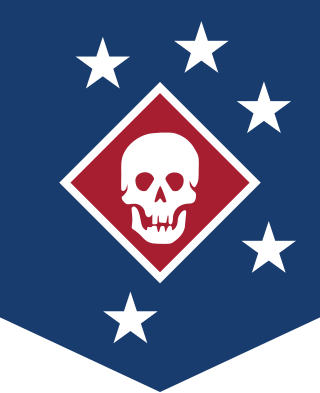
The Marine Raiders were special operations forces originally established by the United States Marine Corps during World War II to conduct amphibious light infantry warfare. "Edson's" Raiders of 1st Marine Raider Battalion and "Carlson's" Raiders of 2nd Marine Raider Battalion are said to have been the first United States special operations forces to form and see combat during World War II.
United States special operations forces (SOF) are the active and reserve component forces of the United States Army, Marine Corps, Navy and Air Force, as designated by the Secretary of Defense and specifically organized, trained, and equipped to conduct and support special operations. All active and reserve special operations forces are assigned to the United States Special Operations Command (USSOCOM).

The 84th Training Command ("Railsplitters") is a formation of the United States Army. During World War I it was designated the 84th Division, American Expeditionary Forces; during World War II it was known as the 84th Infantry Division. From 1946 to 1952, the division was a part of the United States Army Reserve as the 84th Airborne Division. In 1959, the division was reorganized and redesignated once more as the 84th Division. The division was headquartered in Milwaukee in command of over 4,100 soldiers divided into eight brigades—including an ROTC brigade—spread throughout seven states.

Buckley Space Force Base is a United States Space Force base in Aurora, Colorado named after United States Army Air Service First Lieutenant John Harold Buckley. The base is run by Space Base Delta 2, with major units including the U.S. Space Force's Space Delta 4, the Colorado Air National Guard's 140th Wing, the Denver Naval Operations Support Center, and the National Reconnaissance Office's Aerospace Data Facility-Colorado.
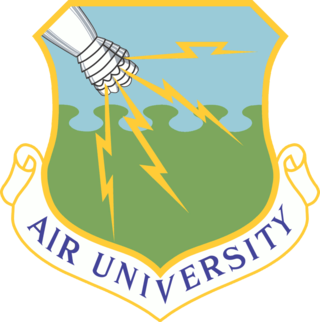
Air University is a professional military education university system of the United States Air Force. It is accredited by the Commission on Colleges of the Southern Association of Colleges and Schools to award master's degrees.
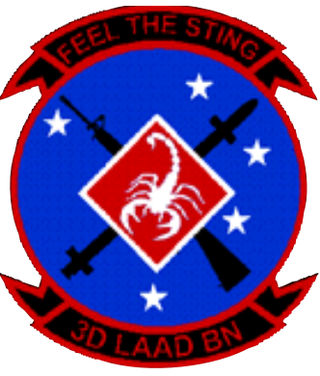
The 3d Low Altitude Air Defense Battalion is an air defense unit of the United States Marine Corps currently responsible for providing short range air defense. The battalion falls under the command of Marine Air Control Group 38 (MACG-38) and the 3rd Marine Aircraft Wing and is currently based at Marine Corps Base Camp Pendleton, California.

The United States Marine Corps is organized within the Department of the Navy, which is led by the Secretary of the Navy (SECNAV). The most senior Marine commissioned officer is the Commandant of the Marine Corps, responsible for organizing, recruiting, training, and equipping the Marine Corps so that it is ready for operation under the command of the unified combatant commanders. The Marine Corps is organized into four principal subdivisions: Headquarters Marine Corps, the Operating Forces, the Supporting Establishment, and the Marine Forces Reserve.

Marine Wing Communications Squadron 28 (MWCS-28) is a United States Marine Corps communications squadron. The squadron provides expeditionary communications for the aviation combat element of the II Marine Expeditionary Force. They are based at Marine Corps Air Station Cherry Point and fall under the command of Marine Air Control Group 28 and the 2nd Marine Aircraft Wing.

Ray L. Smith is a highly decorated retired United States Marine Corps major general. Smith was a combat veteran — receiving the Navy Cross for his heroic actions during the Vietnam War, as well as two Silver Stars, the Bronze Star, and three Purple Hearts. Smith retired from the Marine Corps in 1999 after almost 34 years of service. In 2003, after nearly four years of retirement, Smith went to Iraq with the 1st Marine Division; and penned an eyewitness account of the march from Kuwait to Baghdad — The March Up: Taking Baghdad with the 1st Marine Division.

Marine expeditionary unit (special operations capable) (MEU(SOC)) is a program created by the United States Marine Corps (USMC) and the United States Navy (USN) in 1985 for Marine expeditionary units (MEU). The program enhances MEUs providing them with additional training and equipment to become certified as special operations capable with a Maritime Special Purpose Force (MSPF). The designation special operations capable is unique to the Marine Corps and means in relation to special operations. The role of a MEU(SOC) however is not equivalent to the special operations role of special operations forces. Although considered special operations capable a MEU(SOC) does not form part of the United States Special Operations Command (USSOCOM) established in 1987 or the United States Marine Forces Special Operations Command (MARSOC) later established in 2006.

Communications School is where selected United States Marine Corps commissioned and warrant officers are sent to learn the art and science of planning and employing communications and performing command and staff duties.
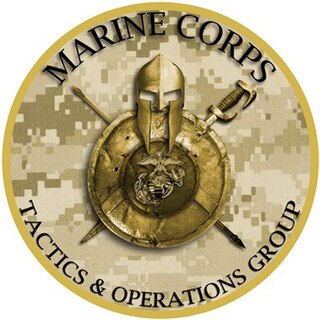
The Marine Corps Tactics and Operations Group (MCTOG) provides advanced and standardized training in Marine Air-Ground Task Force (MAGTF) Operations, Combined Arms Training and Unit Readiness Planning at the Battalion and Regiment levels, and synchronizes doctrine and training standards IOT enhance combat preparation and performance of Ground Combat Element (GCE) units in MAGTF operations. They fall under the command of the Training and Education Command. It was established by General James T. Conway, Commandant of the Marine Corps.
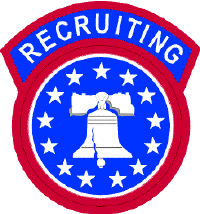
The United States Army Recruiting Command (USAREC) is responsible for manning both the United States Army and the Army Reserve. Recruiting operations are conducted throughout the United States, U.S. territories, and at U.S. military facilities in Europe, Asia, and the Middle East. This process includes the recruiting, medical and psychological examination, induction, and administrative processing of potential service personnel.

Major General William F. Mullen III is a retired officer in the United States Marine Corps. He last served as the commanding general for Training and Education Command. He was deployed in Fallujah, Iraq, in 2007 during Operation Iraqi Freedom. He has co-written a book with Daniel Green called Fallujah Redux: The Anbar Awakening and the Struggle with Al-Qaeda.

David Hilberry Berger is a retired United States Marine Corps general who served as the 38th commandant of the Marine Corps from 2019 to 2023.

Lewis A. Craparotta is a retired United States Marine Corps lieutenant general who last served as the commanding general of United States Marine Corps Training and Education Command. Craparotta previously served as commanding general of Marine Corps Air Ground Combat Center Twentynine Palms.

1st Light Antiaircraft Missile Battalion was a United States Marine Corps air defense unit equipped with the medium range surface-to-air MIM-23 HAWK Missile System. The battalion was the lineal descendant of the 1st Defense Battalion which gained fame during World War II for its defense of Wake Island early in the war. 1st LAAM also deployed to Vietnam in 1965 providing air defense for the Marine Corps in the I Corps sector. The battalion was last based at Marine Corps Air Station Yuma, Arizona and fell under the command of Marine Air Control Group 38 (MACG-38) and the 3rd Marine Aircraft Wing.
Hal Wellman Vincent was a naval aviator in the United States Marine Corps who retired at the rank of major general. A veteran of the Vietnam War, he commanded at the squadron, group and wing level during his career. He flew more than 10,000 hours in over 165 different aircraft and was the first Marine Aviator to fly Mach 2.0.

Steven R. Rudder is a retired United States Marine Corps lieutenant general and Naval Aviator. Rudder has served as Deputy Commandant for Aviation, USMC and Commanding General, United States Marine Corps Forces, Pacific.

Kevin M. Iiams is a United States Marine Corps lieutenant general who serves as the commander of the United States Marine Corps Training and Education Command since August 2, 2021. He most recently served as the Assistant Deputy Commandant for Combat Development and Integration of the United States Marine Corps and Deputy Commanding General of the Marine Corps Combat Development Command. Previously, he was the Commanding General of the 3d Marine Aircraft Wing. In April 2021, he was nominated for promotion to lieutenant general and assignment to reassume his command of the U.S. Marine Corps Training and Education Command, replacing LtGen Lewis A. Craparotta.



















